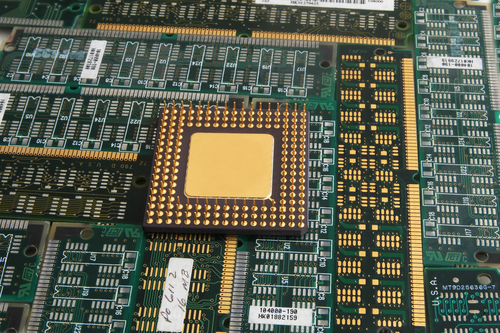
Intel has announced a pair of reference designs that tap into software-defined networking (SDN), launching both a switch and server design that leverage OpenFlow and Open vSwitch protocols. Intel executives suggested they wouldn't sell the Open Networking Platform Switch and Server designs themselves, but make them available to third parties to help develop their own products. Software-defined networking arrives at an opportune time for Intel, a computing powerhouse that has thrived on clients’ need for microprocessors and data-center infrastructure. SDN, which separates the control plane of a switch and allows it to be controlled via a server or virtual machine, is a pitch that Intel can hit. Intel also reported first-quarter earnings April 16, with strong showings in the data center, weaker demand for PC-related products, and the chance to start picking up business within its Intel Architecture group—a grab-bag that covers everything from flash memory and set-top boxes to phone and tablet processors, as well as networking. Intel argues that the cost and complexity of networking equipment is increasing, outpacing those networks’ projected revenues, said Rose Schooler, a vice president in the Intel Architecture Group and the general manager of its communications and storage infrastructure business. "The traditional approaches are very black-box and proprietary," she added, with custom ASICs, form factors, and middleware choking out innovation and requiring specialized service and support. Intel is aiming SDN both at traditional server farms as well as service providers. Schooler insisted that SD reduces power and complexity, and puts innovation where service providers add the most value: in services. In an Intel SDN pilot with Verizon, the telco apparently reported a 90 percent reduction in the time to deployment of new services. Intel's open, top-of-rack switch design is built on the backbone of its Xeon microprocessors, its 89xx communications chipset, and the Intel FM 6700 Fulcrum switch. Atop that runs Wind River Linux, the embedded OS from Intel's Wind River division, OpenFlow, Open vSwitch, plus future open management APIs. The server/virtual switch design is similar, with a small-packet-optimized Data Plane Accelerated Open vSwitch and an Intel 82599 10-Gbit Ethernet controller added to the mix.
Datacenter Continues to Drive Intel
Tuesday afternoon, Intel reported net income for the first quarter of $2.0 billion, down 17 percent from the same period a year ago. Revenue for the quarter was $12.6 billion, down 7 percent. The key numbers were the differences in revenue for the PC Client Group and Intel's datacenter business. Intel's PC client business reported a 6.0 percent year-over-year drop to $8.0 billion, while Intel's datacenter business climbed 7.5 percent year over year to $2.6 billion. Other Intel Architecture group revenue, which includes cash from flash, phone and tablet, and set-top box hardware, dropped 9.0 percent to about $1.0 billion. Intel also said that PC microprocessor unit volumes dropped 7 percent from a year ago, while average selling price rose 1 percent. Within the data center, unit volumes climbed 6 percent, while ASPs rose 2 percent. In the second quarter, Intel executives said, the company will launch Haswell, its next-generation processor architecture, which will help boost demand for PCs in the back half of the year, with ultrabooks costing between $499 and $599 available during the holiday season. Paul Otellini, Intel's chief executive who has said he will retire in May, told analysts that his soon-to-be-former-company’s diversity of markets should allow it to weather any storms. "What gives me confidence in the second half of 2013 really comes down to two things," Otellini said,
according to a transcript. "One, we do expect that the macro environment will improve. That’s consistent with what we’re seeing from most economists now. That could be a repeat to what we thought last year. I think the world was expecting a stronger macroeconomic second half of ’12, but it didn’t materialize. So that is my belief right now. That trend will directly impact Intel’s data center business, he added: "There’s a big portion of that business that really is correlated to GDP growth when you look at it over a long period of time.” Otellini’s second ray of hope was Intel’s product portfolio. “We now participate across a broad range of devices, tablets and convertibles and attachables, and phones, although phones won’t really drive the results in the second half,” he said. “And so we can embrace this broad market for computing now, and wherever the demand increases, we can participate in it."
Image: Andrew Park/Shutterstock.com
 Intel has announced a pair of reference designs that tap into software-defined networking (SDN), launching both a switch and server design that leverage OpenFlow and Open vSwitch protocols. Intel executives suggested they wouldn't sell the Open Networking Platform Switch and Server designs themselves, but make them available to third parties to help develop their own products. Software-defined networking arrives at an opportune time for Intel, a computing powerhouse that has thrived on clients’ need for microprocessors and data-center infrastructure. SDN, which separates the control plane of a switch and allows it to be controlled via a server or virtual machine, is a pitch that Intel can hit. Intel also reported first-quarter earnings April 16, with strong showings in the data center, weaker demand for PC-related products, and the chance to start picking up business within its Intel Architecture group—a grab-bag that covers everything from flash memory and set-top boxes to phone and tablet processors, as well as networking. Intel argues that the cost and complexity of networking equipment is increasing, outpacing those networks’ projected revenues, said Rose Schooler, a vice president in the Intel Architecture Group and the general manager of its communications and storage infrastructure business. "The traditional approaches are very black-box and proprietary," she added, with custom ASICs, form factors, and middleware choking out innovation and requiring specialized service and support. Intel is aiming SDN both at traditional server farms as well as service providers. Schooler insisted that SD reduces power and complexity, and puts innovation where service providers add the most value: in services. In an Intel SDN pilot with Verizon, the telco apparently reported a 90 percent reduction in the time to deployment of new services. Intel's open, top-of-rack switch design is built on the backbone of its Xeon microprocessors, its 89xx communications chipset, and the Intel FM 6700 Fulcrum switch. Atop that runs Wind River Linux, the embedded OS from Intel's Wind River division, OpenFlow, Open vSwitch, plus future open management APIs. The server/virtual switch design is similar, with a small-packet-optimized Data Plane Accelerated Open vSwitch and an Intel 82599 10-Gbit Ethernet controller added to the mix.
Intel has announced a pair of reference designs that tap into software-defined networking (SDN), launching both a switch and server design that leverage OpenFlow and Open vSwitch protocols. Intel executives suggested they wouldn't sell the Open Networking Platform Switch and Server designs themselves, but make them available to third parties to help develop their own products. Software-defined networking arrives at an opportune time for Intel, a computing powerhouse that has thrived on clients’ need for microprocessors and data-center infrastructure. SDN, which separates the control plane of a switch and allows it to be controlled via a server or virtual machine, is a pitch that Intel can hit. Intel also reported first-quarter earnings April 16, with strong showings in the data center, weaker demand for PC-related products, and the chance to start picking up business within its Intel Architecture group—a grab-bag that covers everything from flash memory and set-top boxes to phone and tablet processors, as well as networking. Intel argues that the cost and complexity of networking equipment is increasing, outpacing those networks’ projected revenues, said Rose Schooler, a vice president in the Intel Architecture Group and the general manager of its communications and storage infrastructure business. "The traditional approaches are very black-box and proprietary," she added, with custom ASICs, form factors, and middleware choking out innovation and requiring specialized service and support. Intel is aiming SDN both at traditional server farms as well as service providers. Schooler insisted that SD reduces power and complexity, and puts innovation where service providers add the most value: in services. In an Intel SDN pilot with Verizon, the telco apparently reported a 90 percent reduction in the time to deployment of new services. Intel's open, top-of-rack switch design is built on the backbone of its Xeon microprocessors, its 89xx communications chipset, and the Intel FM 6700 Fulcrum switch. Atop that runs Wind River Linux, the embedded OS from Intel's Wind River division, OpenFlow, Open vSwitch, plus future open management APIs. The server/virtual switch design is similar, with a small-packet-optimized Data Plane Accelerated Open vSwitch and an Intel 82599 10-Gbit Ethernet controller added to the mix.
 Intel has announced a pair of reference designs that tap into software-defined networking (SDN), launching both a switch and server design that leverage OpenFlow and Open vSwitch protocols. Intel executives suggested they wouldn't sell the Open Networking Platform Switch and Server designs themselves, but make them available to third parties to help develop their own products. Software-defined networking arrives at an opportune time for Intel, a computing powerhouse that has thrived on clients’ need for microprocessors and data-center infrastructure. SDN, which separates the control plane of a switch and allows it to be controlled via a server or virtual machine, is a pitch that Intel can hit. Intel also reported first-quarter earnings April 16, with strong showings in the data center, weaker demand for PC-related products, and the chance to start picking up business within its Intel Architecture group—a grab-bag that covers everything from flash memory and set-top boxes to phone and tablet processors, as well as networking. Intel argues that the cost and complexity of networking equipment is increasing, outpacing those networks’ projected revenues, said Rose Schooler, a vice president in the Intel Architecture Group and the general manager of its communications and storage infrastructure business. "The traditional approaches are very black-box and proprietary," she added, with custom ASICs, form factors, and middleware choking out innovation and requiring specialized service and support. Intel is aiming SDN both at traditional server farms as well as service providers. Schooler insisted that SD reduces power and complexity, and puts innovation where service providers add the most value: in services. In an Intel SDN pilot with Verizon, the telco apparently reported a 90 percent reduction in the time to deployment of new services. Intel's open, top-of-rack switch design is built on the backbone of its Xeon microprocessors, its 89xx communications chipset, and the Intel FM 6700 Fulcrum switch. Atop that runs Wind River Linux, the embedded OS from Intel's Wind River division, OpenFlow, Open vSwitch, plus future open management APIs. The server/virtual switch design is similar, with a small-packet-optimized Data Plane Accelerated Open vSwitch and an Intel 82599 10-Gbit Ethernet controller added to the mix.
Intel has announced a pair of reference designs that tap into software-defined networking (SDN), launching both a switch and server design that leverage OpenFlow and Open vSwitch protocols. Intel executives suggested they wouldn't sell the Open Networking Platform Switch and Server designs themselves, but make them available to third parties to help develop their own products. Software-defined networking arrives at an opportune time for Intel, a computing powerhouse that has thrived on clients’ need for microprocessors and data-center infrastructure. SDN, which separates the control plane of a switch and allows it to be controlled via a server or virtual machine, is a pitch that Intel can hit. Intel also reported first-quarter earnings April 16, with strong showings in the data center, weaker demand for PC-related products, and the chance to start picking up business within its Intel Architecture group—a grab-bag that covers everything from flash memory and set-top boxes to phone and tablet processors, as well as networking. Intel argues that the cost and complexity of networking equipment is increasing, outpacing those networks’ projected revenues, said Rose Schooler, a vice president in the Intel Architecture Group and the general manager of its communications and storage infrastructure business. "The traditional approaches are very black-box and proprietary," she added, with custom ASICs, form factors, and middleware choking out innovation and requiring specialized service and support. Intel is aiming SDN both at traditional server farms as well as service providers. Schooler insisted that SD reduces power and complexity, and puts innovation where service providers add the most value: in services. In an Intel SDN pilot with Verizon, the telco apparently reported a 90 percent reduction in the time to deployment of new services. Intel's open, top-of-rack switch design is built on the backbone of its Xeon microprocessors, its 89xx communications chipset, and the Intel FM 6700 Fulcrum switch. Atop that runs Wind River Linux, the embedded OS from Intel's Wind River division, OpenFlow, Open vSwitch, plus future open management APIs. The server/virtual switch design is similar, with a small-packet-optimized Data Plane Accelerated Open vSwitch and an Intel 82599 10-Gbit Ethernet controller added to the mix.

